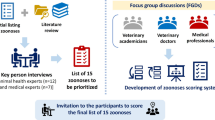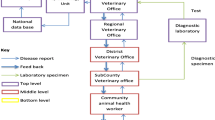Abstract
A semi-systematic literature review of national policies was carried out in relation to surveillance and disease reporting in Pacific Island Countries and Territories (PICTs). It also analysed the animal disease reporting structures in Fiji, Papua New Guinea (PNG), Vanuatu and the Solomon Islands. The strengths, weaknesses, opportunities and threats (SWOT) of those reporting structures were examined in relation to how they impacted the detection and management of animal diseases in PICTs. Field missions collected information on animal disease reporting structures and these were discussed in detail with country officials and documented. The findings from the literature review indicated that there is very little policy to support work in surveillance and disease reporting within national government structures of the countries studied. This increases the potential for disease transmission and the introduction of exotic diseases as the efficiency of disease reporting is low. The findings from the SWOT analysis of the reporting structures indicated that there were commonalities across the countries studied, i.e. reporting structures were long with multiple legs that were not functioning properly and this was worsened when positions were vacant in the reporting structure. The hierarchical nature of the reporting structure also reduced reporting efficiency as reports took a longer time to reach decision makers at the top of the structure. High officer turnover and the shortage of veterinarians in the countries studied also affected the efficiency of disease reporting as most in-county officials were inexperienced and could not recognise disease signs and there were no veterinarians to supervise them. Existing reporting structures need to be reviewed to remove duplication and shorten the chain. However, this could override existing command structures and would need to be documented and awareness created with the officers involved. There also needs to be more collaboration with FAO, OIE, academic institutions and national governments to create an environment conducive for the development of policies that support work on surveillance to improve disease reporting in PICTs. The shortage of veterinarians could be addressed by influencing national governments to create better policies to retain veterinarians in the animal health services; this should be supported by creating reasonable work conditions and remuneration packages. This should also be supported with policies to send young graduates to study veterinary science overseas and have a career path for them when they return. Engagement of retired veterinarians from developed countries and re-evaluating the criteria for veterinarian registration could be short-term solutions to address the shortage of veterinarians in PICTs.





Similar content being viewed by others
References
Atalupe, H., 2014. Personal communication, Deputy Director, Livestock Department, Ministry of Agriculture and Livestock Development, PO Box G13, Honiara, Solomon Islands.
AusAid Report, 2010. PNG Australia Quarantine Twinning Scheme, Australian Agency for International Development, Locked Bag 129, WAIGANI, NCD, Papua New Guinea, p. 32.
Ayalew, W., Kohun, P., Dom, M., Quartermain, A., 2009. Status of livestock production and health research in PNG. National Agricultural Research Institute, Livestock Research Projects, Labu, P O Box 1639, Lae, 411, MP, PNG. University of Natural Resources and Environment, Private mail bag, Kokopo, ENB, PNG., 20.
Borja, L., 2016. Personal communication, Senior Veterinary Officer, Fiji Veterinary Pathology Laboratory, Animal Health and Production Division, Ministry of Agriculture, Koronivia, Nausori, Fiji.
FAO, 2002. Some Issues of Livestock of the Asia-Pacific region, RAP publication no. 2002/06. Food and Agriculture Organization of the United Nations, Regional Office for Asia and the Pacific Animal Production and Health Commission for Asia and the Pacific (APHCA), Bangkok., 20.
FAO, 2015. A national policy for efficient Veterinary Laboratory services- Kenya as a pilot country. FAO Regional Office for Asia and the Pacific, 39 Phra Athit road, Bangkok.
FAO, 2016. Grazing Livestock in the South West Pacific. Viale delle Terme di Caracalla, 00153 Rome, Italy
Fletcher, S., Gero, A., Thiessen, J., Willetts, J., Rumsey, M., Daly, J., Buchan, J., Kuruppu, N., 2013. Understanding the Pacific’s adaptive capacity to emergencies in the context of climate change: Country Report-FIJI. Institute for Sustainable Futures, and WHO Collaborating Centre, University of Technology, Sydney., p. 35.
Gummow, B., 2014. Food Animal Biosecurity Network Project Final Report, Discipline of Veterinary Science, James Cook University, Townsville 4811, Queensland, Australia, p. 31.
Gummow, B., Hedlefs, R., Kapo, N., Kenneally, G., Yombo, A., 2013. An approach to sustainable disease reporting in developing countries European College of Veterinary Public Health, Turin, Italy, 18–20 September.
Häsler, B., Howe, K., 2012. Evaluating the Role of Surveillance in National Policies for Animal Health. Euro Choices Journal 11(2), 6.
Kline, K., McCarthy, J.S., Pearson, M., Loukas, A., Hotez, P.J., 2013. Neglected Tropical Diseases of Oceania: Review of Their Prevalence, Distribution, and Opportunities for Control. PLOS Neglected Tropical Diseases, www.plosntds.org, Volume 7, Issue 1, e1755., p9.
MAF New Zealand, 2008. National Animal Identification and Tracing Systems Launched. Biosecurity Magazine, MAF Biosecurity, New Zealand, PO Box 2526, Pastoral House, 25 The Terrace, Wellington, New Zealand, Email: biosecurity@maf.govt.nz, Internet: www.biosecurity.govt.nz, p. 28.
Ryan S. Miller, Matthew L. Farnsworth, Jennifer L. Malmberg, 2013. Diseases at the livestock–wildlife interface: Status, challenges, and opportunities in the United States. Preventive Veterinary Medicine Preventive Veterinary Medicine 110 (2013) 119–132, 14.
Monica, C., Rhonda, S., 2011. The Pacific Island Countries Fiji, Papua New Guinea (PNG), Samoa, Solomon Islands, Vanuatu and Tuvalu. University of South Australia, University of South Australia, GPO Box 2471, Adelaide, South Australia 5001, Australia.
Mosese, N., 2016. Personal communication, Senior Livestock Officer, Livestock Department, P.M.B 9095, Airport Road, Port Vila, Vanuatu.
National Agriculture Census Report, 2009. National Agricultural Census Report. Economic Planning and Statistics Division, Ministry of Agriculture, Suva, Fiji, P, 391.
OIE, 2010. World Animal Health Reporting Obligations: Fact Sheet. World Organisation for Animal Health 12, rue de Prony, 75017 Paris, FRANCE, E-mail: oie@oie.int, www.oie.int, (2).
Philips, R., 2014. Personal communication, Senior Veterinary Officer, Biosecurity Vanuatu, P.M.B 9095, Airport Road, Port Vila, Vanuatu.
Puana, I., 2016. Personal communication from the Former Chief Veterinary Officer, National Agriculture and Quarantine Inspection Authority (NAQIA), Papua New Guinea, currently Animal Health and Production Advisor, Land Resources Division, The Pacific Community (SPC).
Rich, K.M., Denwood, M.J., Stott, A.W., Mellor, D.J., Reid, S.W.J., Gunn, G.J., 2013. Systems Approaches to Animal Disease Surveillance and Resource Allocation: Methodological Frameworks for Behavioral Analysis. PLOS ONE Journal www.plosone.org.
Secretariat of the Pacific Community, 2009. Policy Brief - Livestock in the Pacific. Private Mail Bag, Suva, Fiji 4.
Secretariat of the Pacific Community, 2016. http://pafpnet.spc.int/policy-bank/countries/fiji (accessed 11/10/16).
SPC, 2016. Pacific Agriculture Policy Project: Policy Bank. http://pafpnet.spc.int/policy-bank (Accessed 28.10.16).
Tukana, A., Warner, J., Hedlef, R., Gummow, B., 2015. The history of brucellosis in the Pacific Island Countries and Territories and its re-emergence. Preventive Veterinary Medicine 122, 14–20.
Tukana, A., Hedlefs, R., Gummow, B., 2016. Brucella abortus surveillance of cattle in Fiji, Papua New Guinea, Vanuatu, the Solomon Islands and a case for active disease surveillance as a training tool. Tropical Animal Health and Production Journal, DOI https://doi.org/10.1007/s11250-016-1120-8.
WHO, 2017. Managing zoonotic public health risks at the human-animal-ecosystem interface. http://www.who.int/foodsafety/about/flyer_zoonoses.pdf?ua=1. (Accessed 29 April 2017)
Yombo, A., 2010. Syndromic animal health surveillance in Papua New Guinea. Is it working?. (Masters in Tropical Veterinary Science Thesis, James Cook University, Australia).
Acknowledgements
The authors wish to thank the following people for their collaboration and assistance: Mr. Tomasi Tunabuna (Director Animal Health) and Dr. Leo Borja (Senior Veterinary Officer) of the Animal Health and Production Division in Fiji). Mr. Andrew Yamanea (Managing Director), Dr. Nime Kapo (Chief Veterinary Officer), Mr. Andy Yombo (Senior Epidemiologist) and Dr. Peter Wai’in (Laboratory Manager, Kilakila) of the National Agricultural Inspection Authority in Papua New Guinea. Mr. Lonny Bong (Director Livestock), Mr. Nambo Moses (Senior Livestock Officer), Mr. Alain Kutoslowo (Livestock Officer), Dr. Peter Hoyle (Senior Veterinary Officer, Santo) and Dr. Roger Phillip (Senior Veterinary Officer, Port Vila) of the Livestock Department in Vanuatu. Mr. Barney Keqa (Director Livestock), Mr. Hearly Atapule (Deputy Director Livestock) and Dr. Emma Rooke (Chief Veterinary Officer) of the Livestock Department in the Solomon Islands. Associate Professor Jeffrey Warner (Discipline of Biomedical Science, James Cook University, Australia). The authors also thank ‘The Secretariat of the Pacific Community’, i.e. the Animal Health and Production team advisor, Dr. Ken Cokanasiga, Animal Health Specialist, Dr. Ilagi Puana and the Animal Production Specialist Mr. Nichol Nonga for the support they provided to the project.
Funding
The authors thank the Australian Aid program (AusAid agreement no. 57668) for approving and supporting the research technically and financially.
Author information
Authors and Affiliations
Corresponding author
Ethics declarations
All applicable international, national and/or institutional guidelines for the care and use of animals were followed. All procedures performed in studies involving humans and animals were in accordance with the ethical standards of the James Cook University policy and guidelines. Ethical approval to carry out the study was obtained from the human and animal ethics committees at the university (approval reference: A1740).
Conflict of interest
The authors declare that they have no competing interests.
Rights and permissions
About this article
Cite this article
Tukana, A., Hedlefs, R. & Gummow, B. The impact of national policies on animal disease reporting within selected Pacific Island Countries and Territories (PICTs). Trop Anim Health Prod 50, 1547–1558 (2018). https://doi.org/10.1007/s11250-018-1594-7
Received:
Accepted:
Published:
Issue Date:
DOI: https://doi.org/10.1007/s11250-018-1594-7




